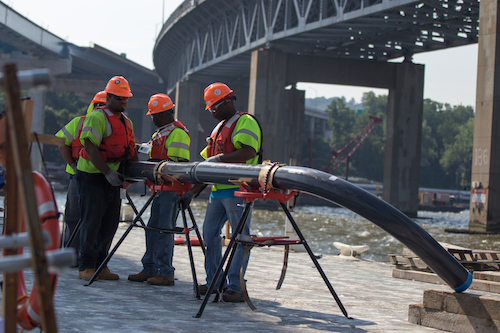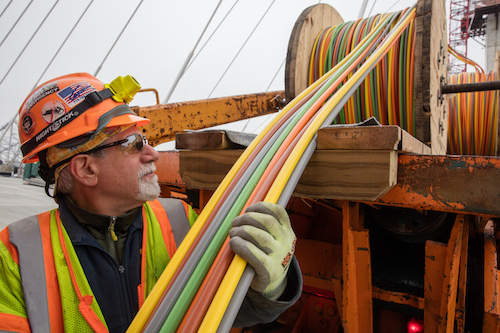The Hudson River crossing between Nyack and
Tarrytown, N.Y., is a terrible place to build a bridge. The river is three miles across,
one of the widest spots on the entire river, where, in places, the bedrock sits
deep beneath hundreds of feet of sandy riverbed.
The river’s banks, lined north and south with homes, businesses and vigilantly protected wetlands, offer no place for staging construction materials, and to complicate things further, there was already a bridge in the way – the 60-year-old Tappan Zee, a bridge so underbuilt due to the Korean War-era steel shortage that replacement planning began almost as soon as the ribbon was cut.
Every day, nearly 140,000 cars crossed the rickety four-lane artery, one of the most notorious chokepoints along the New York State Thruway, the lifeline linking New York City to the rest of the state and New England beyond.
So how did such a difficult, ambitious and desperately-needed infrastructure project – a bridge replacement that had been stalled for decades – get delivered on time and under budget?
Without drama.

|
Bridge spans –some hundreds of feet long—were welded and shaped near Albany and floated downriver 100 miles to the site.
Photo Credit: New York State Thruway
|
On Labor Day 2018, after decades of delays and worries, the Gov. Mario Cuomo Bridge, a $4 billion, 3-mile, twin-span cable stayed bridge was on track to be delivered, as promised, built in just five years with union labor and American steel.
“Was there any real bad news once we started building? I didn’t hear any,” said International Executive Council Chairman and New York Local 3 Business Manager Chris Erikson. “Nothing.”
The straightforward, no-drama construction process of the new bridge stood in stark contrast to the white-knuckle experience of driving across the old Tappan Zee, which 30 years ago exceeded its original expected traffic volume by five times.
“You would drive over it, and they would have these large steel plates in front of you in patches on the roadway,” said New York Gov. Andrew Cuomo at the opening of the first span last August. “And the vehicle in front of you would go over the steel plate, and it would move just a little bit. And you would see a little sunlight coming through the crack in the roadway. And I would say, ‘My luck, that steel panel's going to move, and I'm going right down.’ And I would play it out in my mind. Do I take off the seatbelt, do I open the window? I think it traumatized an entire generation.”

|
Members of New York Local 3 and New City, N.Y. Local 363 shared the electrical work. Here, workers assemble conduit on a temporary floating platform.
Photo Credit: New York State Thruway
|
In 2012, after 30 years of planning and more than 400 meetings, a replacement was agreed on and construction began.
Electrical work was split between three signatory contractors: Welsbach Electric, Schupp Line and LB Electric. Local 3 and New City Local 363 divided up the work nearly along the jurisdictional border which runs down the Hudson River.
To meet the tight cost targets and tighter confines, the winning contractors came up with an audacious plan: build the bridge in sections 100 miles north at the Port of Coeymans and float the pieces 20 hours downriver to the construction site.
Bridge piles, steel pipes three to six feet in diameter in 12-foot sections, were welded together –the longest was more than 300 feet long – at Coeymans. A thousand of them were driven into the river bottom until they hit bedrock. Then they were drained and refilled with steel-reinforced concrete.
After the piles were laid, work began on the bright blue girders, 9 feet high and in sections a few dozen feet long. Ironworkers bolted them together upriver until they were hundreds of feet long and 40 feet wide. Then the wiremen took over, installing the substations, conduit, fiber optic communication and electrical lines for bridge lighting and components.
Instead of hanging 130 feet above wind and water, the IBEW wiremen did their work just over a ladder’s climb from the ground.
“There were substations on the bridge and conduit work that was all attached to the girders while in Coeymans,” said Local 3 Business Representative Tom Capurso. “If a girder was going to Local 3’s side of the bridge, we did the work. When a girder would be on Local 363’s side of the bridge, they did. It was all worked out in the project labor agreement before we started.”
When the girder sections were complete, they were loaded on barges, ready to ferry thousands of tons of steel to the bridge site. As construction got into full swing, with more than 125 IBEW members working, there were always three barges on the river. One, laden, heading down, one unloading at the crossing and one on its way back north for more.
The essential tool that made it all possible was the massive floating crane known as I Lift NY, with a 360-foot tall, 64-foot-wide boom that could lift nearly 2,000 tons at a throw. The crane has no equal in the Western Hemisphere and was sailed 6,000 miles through the Panama Canal after it finished work on the San Francisco-Oakland Bay Bridge replacement.

|
An IBEW member unspools wiring for the main span.
Photo Credit: New York State Thruway
|
Everything that made the new bridge came by boat, including the workers. The river was like a dancehall, with construction tugs, barges and worker taxis weaving between first one, then two, then three bridge spans and the normal bustle of commercial shipping and pleasure boaters. Work only slowed when the river froze solid or wind whipping down from Canada covered the stairs and approaches with a glassy shell of ice.
“Some individuals were on boom lifts 120 feet in the air on the barges,” Capurso said. “A boat throws off a 2-foot wash and the barge would rock with you out at full extension. All you could do was duck down and ride it out.”
Much of the IBEW’s work is invisible, except the 1,400 color-changing LEDs that shine from the concrete pile caps floating the bridge on rays of light. The New York State Thruway Authority can change the colors of the lights to mark holidays or championships by any of New York’s professional sports teams.
Unlike Boston’s Big Dig – which started with a $2.6 billion price tag and ended with a $14.8 billion one – or the new San Francisco Bay Bridge, which started with a $250 million estimated cost and ended north of $6 billion, the Cuomo Bridge had an initial planned cost of a hair over $4 billion and never budged.
All that’s left is for the thousand-ton sections of the old bridge to be cut apart, lowered to barges and then dumped off the coast of Long Island, forming the foundations of ocean reefs that will help protect New York’s coastline from the savagery of future hurricane seasons.
At the opening of the first span, Cuomo thanked the men and women on the job.
“I thank them. Once again, the 7,000 workers who we pushed to work holidays and weekends, they did over 9 million hours in the cold, in the heat, in the snow, in the sleet, the union workers who built this project,” he said.
“This is a 100-year guarantee bridge,” Cuomo said, noting that it could have been done more easily and cheaply, like the Tappan Zee it replaced. “But our responsibility as parents and citizens is to leave this state a better state for you. And that's what was done for us, and this is our investment and our gift to you and to your children.”
Despite the complicated planning process and decades of political hand wringing and delays, the remarkable thing for Local 363 Business Manager Sam Fratto was how unremarkable the job was.
“It was a good job. It employed our members for a few years and showed what we can do,” he said. “It was nice to get those calls from the contractors telling us how good our electricians were, but we knew. We know who we are.”